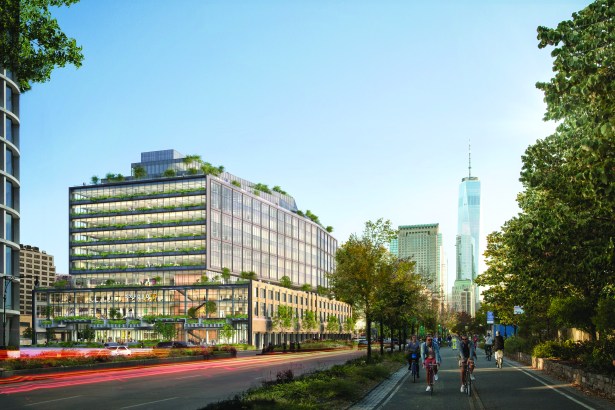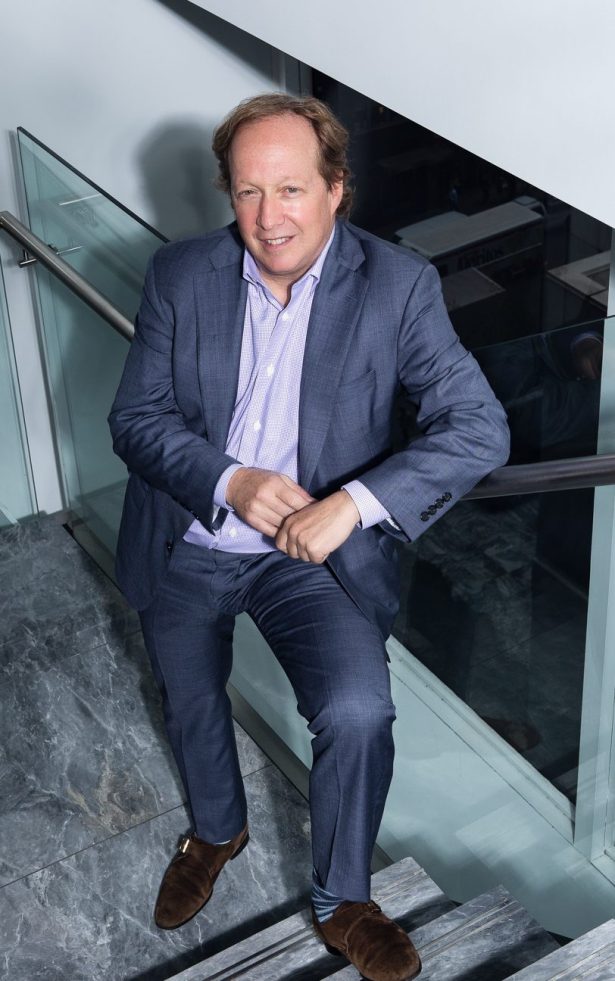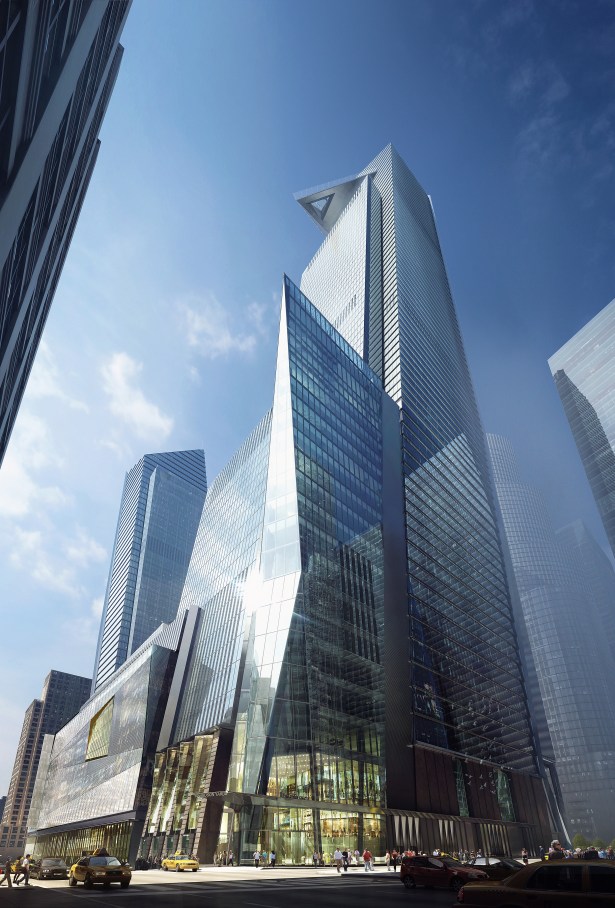Oxford Dean: Dean Shapiro Explains Why Oxford Believes in Midtown South

“I have to tell you,” Dean Shapiro said, when he first heard about Related Companies and Oxford Properties Group’s plan to rebuild the Far West Side of Manhattan, “I came into it with a little cynicism.”
Could you really blame him? Building a mini-city in a place so remotely located was a stretch for a lot of born-and-bred New Yorkers, like Shapiro.
“Everybody was cynical about Hudson Yards,” Shapiro remembered. “It had been talked about for decades. Particularly in 2011 when we were still reeling from the financial crisis—it sounded like a bit of a pipe dream.”
However, much of the cynicism melted away when he fielded a call from his old mentor Blake Hutcheson—then the CEO of Oxford Properties Group, the real estate arm of the Canadian pension fund Omers—who offered him the chance to actually work on, in Shapiro’s words, “the biggest deal anybody will ever work on.”
The 56-year-old divorced father of two—ages 19 and 22—is now Oxford’s head of U.S. development, and he hasn’t stopped at Hudson Yards, the 19-million-square-foot, 14-acre complex on the Far West Side. Earlier this year, Oxford closed on a $700 million purchase of half of St. John’s Terminal from Atlas Capital Group and Westbrook Partners, the plans of which Oxford unveiled earlier this month.
Shapiro spoke about both deals from his office at 450 Park Avenue between East 56th and East 57th Streets, just three short blocks from where he grew up (he now lives in Greenwich Village).
Commercial Observer: The big news of the day is St. John’s Terminal. The reports came out earlier this month, but the details were a little vague. What are you guys planning on doing with the property?
Dean Shapiro: We’re developing it into a 1.3-million-square-foot office building with the potential for a little bit of retail on the ground floor.
What drew you guys to that particular site?

I think a bunch of things. The dimensions of the site. What’s happening in the immediate area. What’s happening in the city. I would say what’s happening globally in terms of the evolution of the workplace. It’s a combination of all those things.
How did the deal come about—did you approach Westbrook and Atlas?
No, it was widely marketed. We were in the loop on that—we’re an active buyer. And we decided early on that it was something we wanted to take a real shot at and that means we do all our analysis; we talk to everybody; we begin to do our work internally that’s necessary. And I’d say most importantly we forged a relationship with the seller, which was critical in this process. Because it wasn’t just an outright sale, it was a sale of part of the property and they were retaining a piece. The continuing relationship with the seller is critical to what they’re doing.
You mentioned one of the things that you were most intrigued by was the location—tell us why you guys like the location?
Hudson Square is on fire right now. [Trinity Church Real Estate] just announced the big Disney deal [to purchase 4 Hudson Square for $650 million]. There’s a lot happening there. The Trinity portfolio is super successful. The profile of tenants going there is becoming more diverse. And I think with the evolution of the workplace there is a desire to do two things through real estate: reinvent branding and also compete effectively for talent through creating something that is very different from what people are used to.
In terms of building something so large, do you think there’s still space in the market for that?
Absolutely—100 percent.
Have you guys talked to any tenants yet?
We have.
I take it I can’t pry out of you who, right?
No. But we’ve talked to a number of tenants from multiple industries and there is a high degree of interest.
Now, your other marquee project, Hudson Yards, is also on the Far West Side of Manhattan. Is there a reason you’re looking at the Far West Side more than any other place?
There’s been a trend for some time for tenants moving south and west for a couple of reasons. One is it’s sort of the final frontier for development. That’s a generalization but there’s a potential for a lot of development in that area. And not just that you can build a lot but you have some latitude about what you build—so there’s the potential for customization. And it’s just cool. People want to live south and west. Hudson Yards enjoys enhanced access to the extension of the 7 train but also new development spurs new development. So with Hudson Yards and the High Line together there’s been a whole renaissance of north Chelsea—and people gravitate to new and cool.

Is there a particular type of tenant you’ve been talking to about those locations?
The beauty of what we’ve seen over there—and the beauty of New York—is that we have a very deep bench from multiple industries. To be specific, when we built Hudson Yards with Related, the expectation based on history was the anchor tenant would be from the financial services industry—because generally that is who seeded large-scale new developments. But our first tenant was a fashion tenant: Coach. And then it was L’Oreal, which is a cosmetics company. Then SAP, which is a technology company. And then Boston Consulting Group—that’s a management consulting firm. And then Time Warner, which is a media company. We didn’t hit financial services until way down the line—and arguably the first one wasn’t even traditional financial services, it was private equity, which was KKR. Then we got Wells Fargo to come. Then we got BlackRock to come.
The city and the country in general went through some tough economic times when you started. It’s interesting that you have this ongoing project to constantly work on as the cycle goes down…
Cycles.
Cycles.
We’re working in multiple product times over a long period of time. We’re going to go through everything. The history of Hudson Yards—as you probably know—Related was not the original winner of the tender. It was Tishman Speyer who had Rupert Murdoch’s company in tow. And it all came apart after the financial crisis. So they exited and it went back to Related as the runner-up in the original tender. We came in at the 11th hour because Related needed a partner. We signed an agreement with the [Metropolitan Transportation Authority] in May of 2010 that was restructured to allow for pragmatic development, assuming the country recovered appropriately and in a manner that was conducive reasonably to development. I don’t think anybody completely predicted how Hudson Yards would unfold, but we knew the magnitude of this and the opportunity was too good to pass up.
What was Oxford’s relationship like with Related prior to that?
Oxford and Related had no relationship, per se. Blake Hutcheson—our CEO—had a relationship with Jay Cross, who’s the president of Hudson Yards. That’s where this started. They were old friends. Y’know, Canada’s a funny place. Canada has roughly the same land area as the United States, but only one-tenth the population. So, there’s only 30 million people in Canada. It’s also fairly stratified. Anybody who’s anybody pretty much is once removed from everybody else who’s somebody. So, relationships are critical in Canada—particularly in Toronto. Canadians are used to doing business with people predicated on relationships—and that was the case here. It was a pre-existing relationship and a trust between Blake Hutcheson and Jay Cross, and that was the nucleus of our relationship—how we got into it. It came down to a phone call.

The roots of Oxford are as a pension fund. Tell us how New York fits into its plans.
New York is one of a very small handful of cities we’re choosing to invest in over the long term and that’s the only way we invest. We get into markets and we go long—meaning we hire locally, we hire for the long term, we put together a full-service team. And we buy. We’re not flippers. We’re not an opportunity fund. We’re a pension fund. Well, we’re a real estate company owned by a pension fund. We have one client, basically. And our mission is to create an income stream to pay pensions. We got [into this office] with two [people]—we’re now at, I don’t know, probably 50? We have both a credit side and an equity side. On the equity side we have an interest in 650 Madison [Avenue], we own this building [450 Park Avenue], we own Olympic Tower [at 641 Fifth Avenue] and we own some other small things. We continue to be acquisitive. St. John’s Terminal comes just at the right time for us. It’s our first development project leading in the U.S. and a very big step for us in New York.
Is that going to be a pattern that you guys are going to continue—ground-up construction?
Yup, we are.
Any particular areas?
We have to be a bit opportunistic. I will tell you we love the Hudson Square area. We know it particularly well. We all really understand the office market and I think to a degree the residential market. I would rule nothing out. I think it’s unlikely that we will do anything in the short term that’s not in Manhattan.
Dean, in your role you’ve got your eye on the country as a whole. What other markets do you like?
We’re selective about the markets in which we invest; those are markets where we have full-service offices. We will not work otherwise. And our role right now is not to work as passive money—we’re active money. We’re either leading or co-leading. That means it will be in one of three other cities—Boston, Washington [D.C.] and San Francisco; that’s it. In time maybe we will gravitate towards other markets, but I can’t tell you today we’re going to do that.
What’s Oxford doing in Washington right now?
We developed 600 Massachusetts Avenue with the Goulds, and I would say we are going to soon begin development of 900 New York Avenue, and we own about a half-dozen assets in that market.
Are those offices?
Yes.
So you’re not jumping into residential yet.
Not yet—but we like residential.
Tell me a little bit about how you wound up at Oxford.
Blake Hutcheson, our CEO, was a close friend from CB [before it became CBRE]. He ran Canada and Latin America, I ran New York. I was a part of a program called, “Emerging Leaders” and he was the mentor of that program, and we developed a strong bond. We both left CB at roughly the same time—I, to go into the development side, with a company in Stamford, Conn. called BLT—Building and Land Technology—and he became the president of a hedge fund called Mount Kellett Capital Management. He lived in New York and we continued to maintain a close personal relationship. He called me one day and said, “I just bought into Hudson Yards and you’re coming over.” So that’s what happened. And I always wanted to work with him.
How did you get the real estate bug originally?
My mother was in it. And I was recruited out of [Cornell University] business school. It just fit with me culturally. I worked for a company that doesn’t exist any more—E.S.G., Edward S. Gordon Company—and I was hired into the consulting group. And it turns out those guys are mostly still together. They’re really the superbrokers among us. Lewis Miller. Greg Tosko. Mike Geoghegan. Howard Fiddle. Those are all my ex-partners. For about nine years or so, I had about nine different jobs there because I was a very good utility player. And as the company grew and went through two different iterations of ownership, there were lots of opportunity to do different things. I ultimately ran the New York business.
Blake Hutcheson has left his role as CEO?
He’s still chairman. He’s moved over to a different role at Omers.
Has there been any change in terms of how the business is being run?
I think we’re continuing to evolve. We have a new president, Michael Turner, who’s a wonderful human being and a really smart guy and has—as you would imagine—his own views for the future and how we should be positioning ourselves. He’s putting his fingerprints on how we’re operating—and he does it highly collaboratively with other senior people in the organization.
Is there a new direction that the company is going to take?
We think technology is going to have a very big influence on what we’re doing—coworking, etc.—as well as taking a real look at our strategy, where we’re concentrated and what the future holds. Do I think it’s a radical departure? No. But I think prudently we’re constantly evaluating how we’re operating, how to make things better and how to position ourselves to reach our objectives. Michael has brought some fresh air because he’ll take nothing for granted. He wants to treat everything like it’s day one.
What about parts of the portfolio like this building here and other Midtown properties—how have things been going in terms of tenants, leases, etc.?
The office side has gone great. We own trophy boutique buildings and that’s been a strong market. People want to be in this building and they don’t want to leave this building. It’s got a very special feel to it. First, it’s at 57th [Street] and Park [Avenue]. Two, it’s got great views. And, third, it feels like a club. And I think there’s always a place in the market for buildings like that. 650 Madison is very similar and Olympic Tower has only three tenants, the NBA being the largest. There’s not a lot of roll.
We buy really good assets because that’s who we are from a quality perspective—but we also think it makes sense because good times or bad, you’ll remain occupied. The retail side is going through an evolution right now; but again we have buildings that are really well located so we get more than our fair share of deals.
You mentioned trophy assets. There have been a few big sales this year like yours and Google’s for the Chelsea Market building, but otherwise it seems like a lot of the trophy assets haven’t been trading hands. Why do you think that is?
I don’t know. You’re right, it’s been a bit of a desert lately. Financing rates are up so that depresses value. Maybe people believe that interest rates are going to drop and it’s probably better to wait. But there’s precious little on the market and people [want to build]. There were 11 bidders for St. John’s—all the likely candidates. People want to develop if they think it makes sense.


